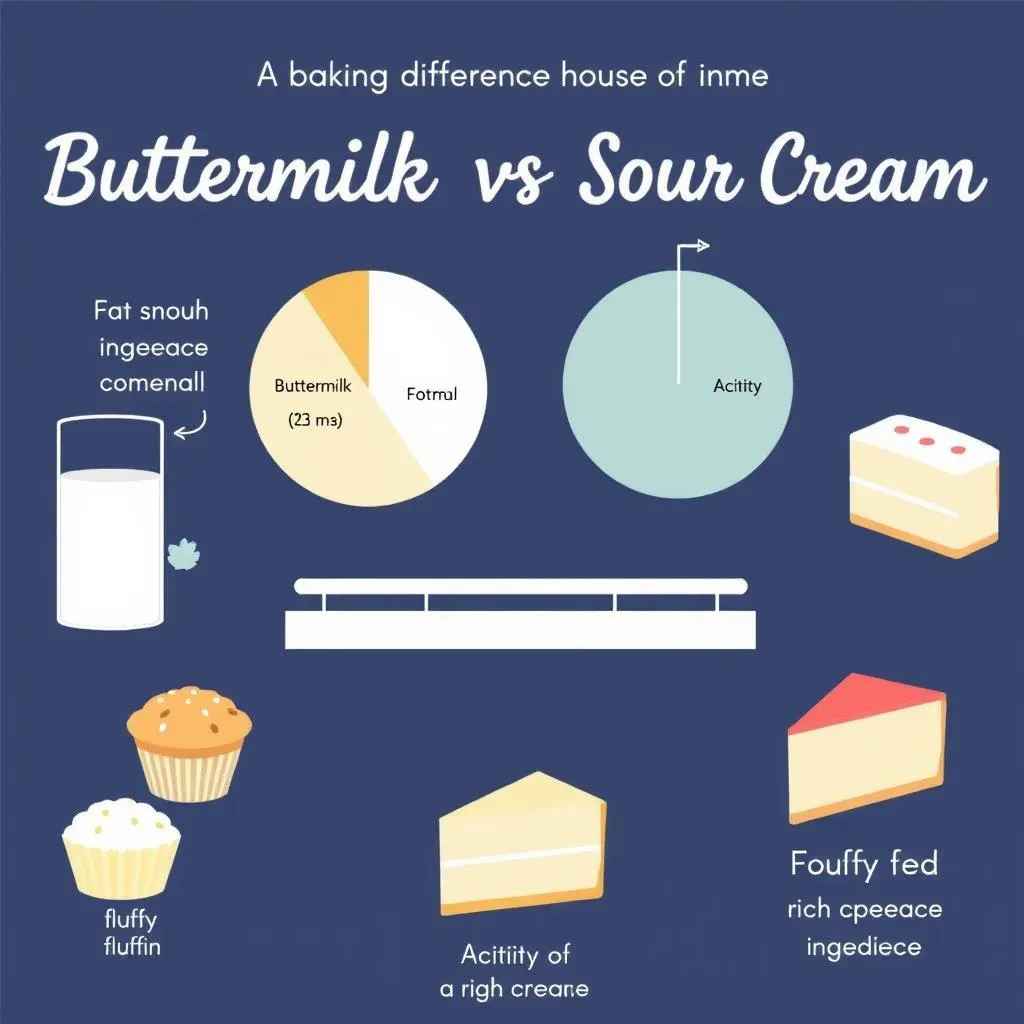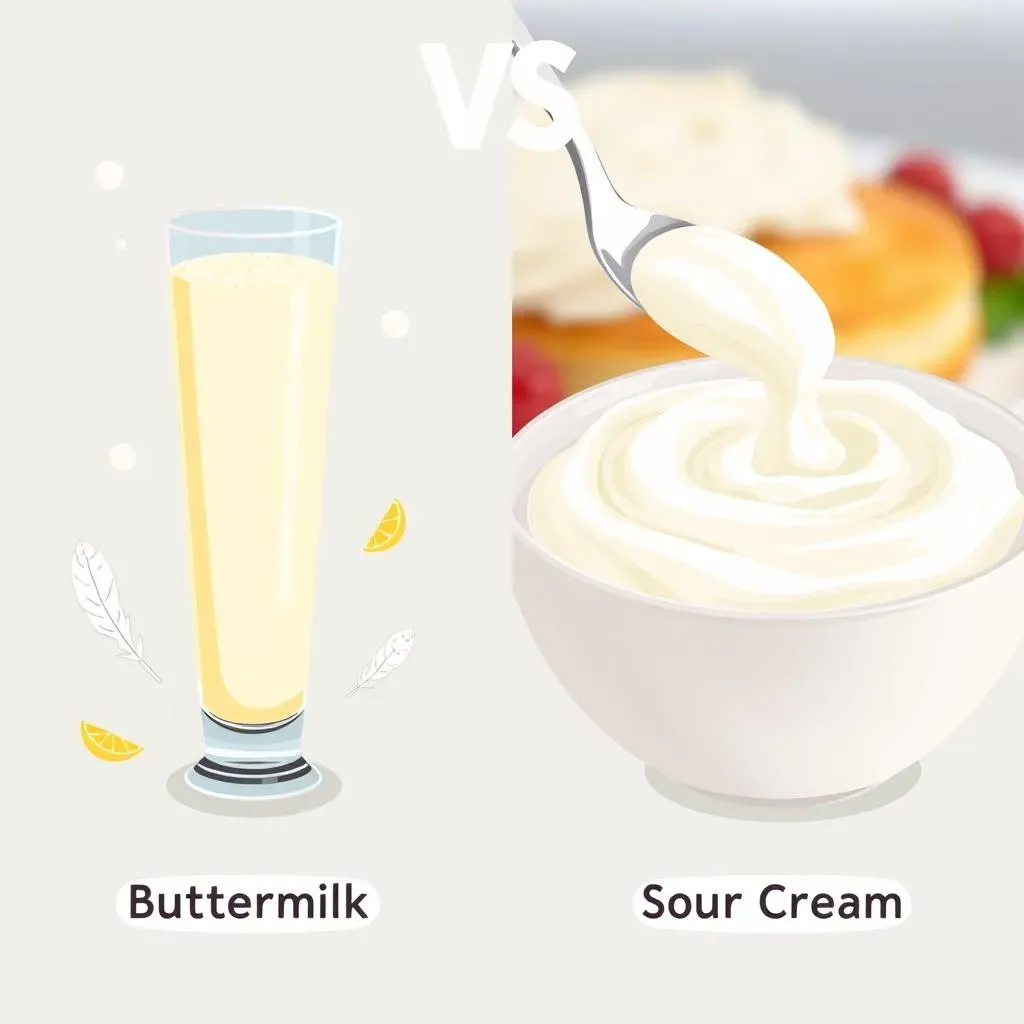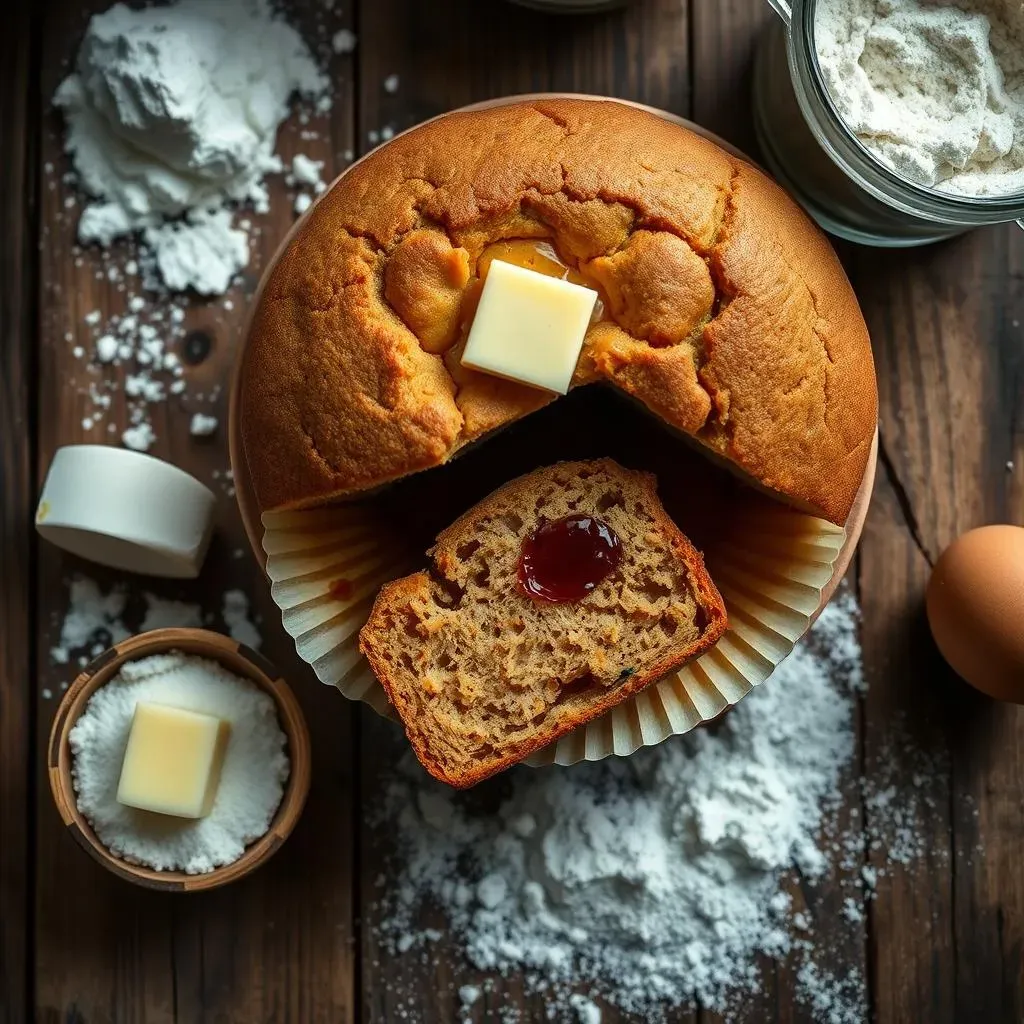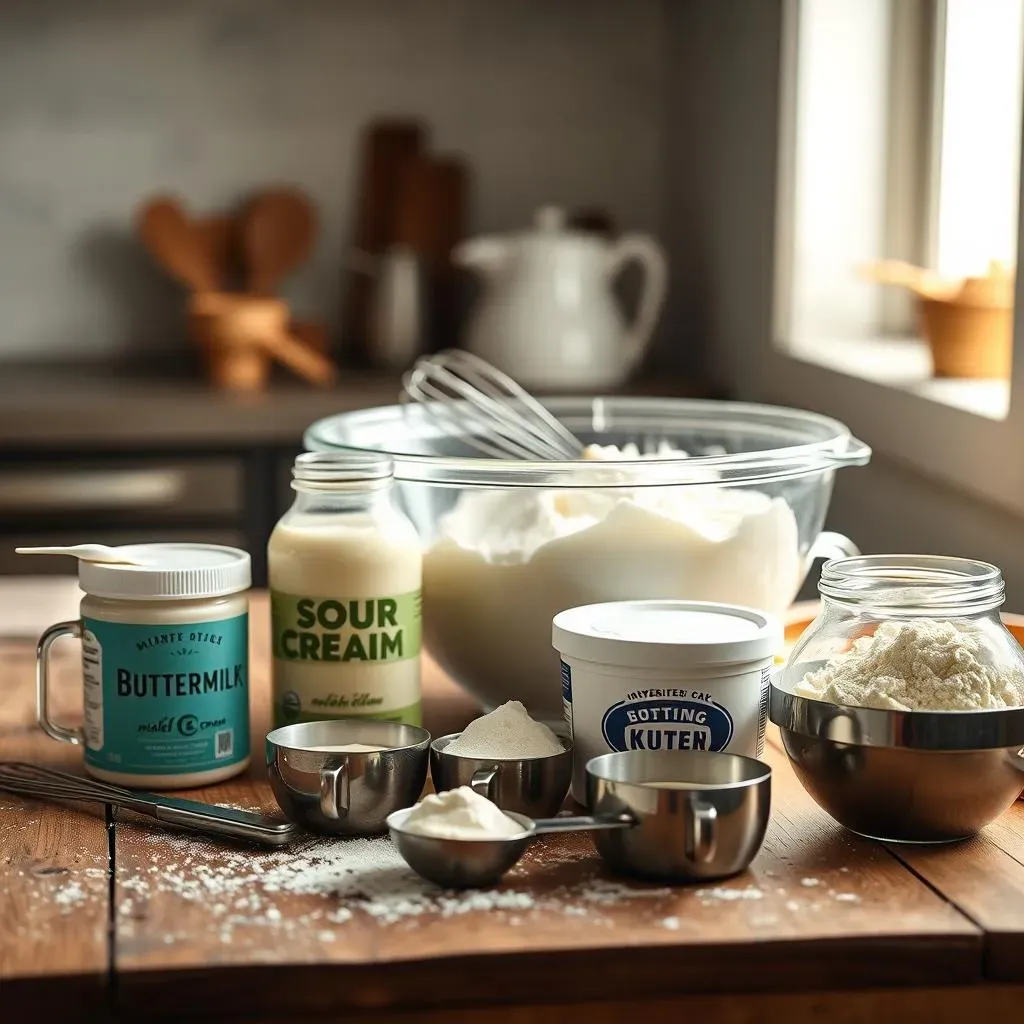Table of Contents
Ever stared blankly at a recipe, realizing you're missing a key ingredient – sour cream? And your pantry only holds buttermilk? Don't despair! This article tackles the burning question: can buttermilk be substituted for sour cream? We'll explore the subtle yet significant differences between these two dairy delights, revealing when a swap is a smart move and when it might lead to culinary catastrophe. We'll unpack the science behind their distinct properties – acidity, fat content, and texture – explaining why they behave differently in various recipes. Then, we'll delve into practical, real-world examples, providing guidance on how to successfully substitute buttermilk for sour cream in baking and other applications, along with crucial considerations to ensure your culinary creations are a triumph, not a flop. Prepare to become a buttermilk-to-sour-cream substitution expert! Let's uncover the secrets to achieving delicious results, even when your pantry isn't perfectly stocked. By the end, you'll confidently answer the question: can buttermilk be substituted for sour cream? And more importantly, *how* to do it right.
Can Buttermilk Replace Sour Cream in Baking?

Can Buttermilk Replace Sour Cream in Baking?
So, you're wondering if you can swap buttermilk for sour cream in your baking? It's a common question, and the answer, like most things in baking, is "it depends!" Buttermilk and sour cream, while both tangy dairy products, have different fat and moisture contents. Sour cream is much richer and creamier, contributing significantly to the texture and richness of baked goods. Buttermilk, on the other hand, is thinner and more acidic. This acidity is fantastic for activating baking soda, creating a light and airy texture. However, this same acidity can sometimes clash with other ingredients, leading to an unexpectedly sour or even bitter taste. Directly substituting buttermilk for sour cream without adjusting the recipe might result in a drier, less rich, and potentially overly acidic final product. For a more detailed guide on buttermilk substitutions, check out this helpful article: buttermilk substitution guide.
Ingredient | Fat Content (approx.) | Acidity |
|---|---|---|
Sour Cream | 18-20% | Moderate |
Buttermilk | 2% or less | High |
Think of it this way: sour cream adds richness and creaminess, while buttermilk provides tang and leavening power. If your recipe relies heavily on the creamy texture of sour cream, like in a coffee cake or cheesecake, a straight swap might not work well. However, in recipes where the tang is more important, and the texture is less crucial, like in some muffins or pancakes, buttermilk might be a suitable alternative. Always consider the recipe's other ingredients and the desired outcome before making the swap. For instance, if your recipe uses baking powder instead of baking soda, you'll need to be even more careful about using buttermilk as a substitute for sour cream because the high acidity might affect how the baking powder works. We'll explore specific examples and techniques in the next section to help you make informed decisions. Let's explore more about the differences between these two ingredients and how that impacts your baking!
- Consider the recipe's overall balance.
- Think about the texture and flavor you want.
- Adjust other ingredients as needed.
Understanding the Differences: Buttermilk vs. Sour Cream

Understanding the Differences: Buttermilk vs. Sour Cream
Fat Content: The Creamy Conundrum
Let's talk fat! Sour cream is a heavyweight champion in the dairy world, boasting a fat content usually between 18% and 20%. This high fat content is what gives it that luscious, creamy texture and rich mouthfeel. It's the star ingredient in many decadent desserts, lending its velvety smoothness to cheesecakes, frostings, and dips. Buttermilk, on the other hand, is a lightweight contender. Its fat content is significantly lower, typically around 2% or less. This lower fat content translates to a thinner, more liquid consistency. Think of it like this: sour cream is a luxurious velvet robe, while buttermilk is a crisp cotton shirt.
This difference in fat content significantly impacts how each ingredient affects baked goods. Sour cream adds richness and moisture, creating a tender crumb. Buttermilk, being lower in fat, can lead to a drier texture if not carefully managed. For more insights into successful substitutions, check out our comprehensive guide on buttermilk substitutions.
Ingredient | Fat Content (approx.) | Impact on Baking |
|---|---|---|
Sour Cream | 18-20% | Adds richness, moisture, tender crumb |
Buttermilk | 2% or less | Can lead to drier texture if not adjusted |
Acidity: The Tangy Twist
Now, let's talk tang! Both buttermilk and sour cream possess a distinct tartness, but their acidity levels differ. Buttermilk packs a more potent acidic punch due to its fermentation process. This high acidity is a baker's secret weapon, activating baking soda and creating a light and airy rise in baked goods. It's like a tiny explosion of flavor and texture! Sour cream, while tangy, has a milder acidity. This gentler acidity contributes to a pleasant tang without overpowering other flavors in a recipe.
The difference in acidity is crucial when considering substitutions. In recipes relying on baking soda's leavening power, buttermilk's higher acidity can be advantageous, even enhancing the final product. However, in recipes using baking powder, buttermilk's high acidity can sometimes interfere with the leavening process, resulting in a flat or dense texture. It’s essential to understand your recipe’s leavening agent before making any substitutions. Remember, careful consideration is key for successful baking! Need more help? Our guide on sour cream substitutes offers valuable tips and tricks.
- Buttermilk: High acidity, activates baking soda
- Sour Cream: Moderate acidity, milder tang
- Consider leavening agent (baking soda or powder)
Successful Buttermilk Substitutions for Sour Cream Recipes

Successful Buttermilk Substitutions for Sour Cream Recipes
Muffins and Quick Breads: A Buttermilk Boon
Let's start with muffins and quick breads! These recipes often benefit from buttermilk's tang and leavening power. The slightly drier texture that buttermilk can impart is often less noticeable in these recipes, as they tend to be naturally more moist. In fact, the added acidity can even enhance the overall flavor profile, creating a brighter, more complex taste. You can usually substitute buttermilk for sour cream in a 1:1 ratio without significant adjustments, especially if your recipe already includes baking soda. For a deeper dive into successful substitutions, check out our guide on buttermilk substitutions.
However, keep an eye on the overall moisture level. If your recipe already contains other dry ingredients, you might need to slightly reduce the amount of buttermilk to avoid an overly dry final product. Remember, baking is a delicate balance of ingredients. A little experimentation might be needed to find the perfect ratio for your recipe and your taste preferences. Want to learn more about mastering buttermilk substitutions? Our detailed article on sour cream substitutes offers invaluable insights.
- Start with a 1:1 ratio.
- Monitor moisture content.
- Adjust as needed based on other ingredients.
Cakes and Cupcakes: A Cautious Approach
Now, let's move on to cakes and cupcakes – a bit trickier territory when substituting buttermilk for sour cream. Here, the richness and creaminess of sour cream play a vital role in the final texture. Buttermilk's lower fat content and higher acidity can lead to a drier, less tender crumb if you make a direct swap. The increased acidity might also clash with the sweetness of the cake, creating an unbalanced flavor profile.
To make a successful substitution, you'll likely need to adjust the recipe. You might consider adding a bit of oil or melted butter to compensate for the missing fat. You may also need to reduce the amount of buttermilk slightly to prevent the cake from becoming too dense or dry. Experimentation is key here. It’s always wise to start with a smaller batch to test your adjustments before committing to a full-sized cake. Need more guidance on making successful substitutions? Our extensive guide on buttermilk substitutions can help you achieve baking perfection.
Adjustment | Reason |
|---|---|
Add oil or melted butter | To compensate for lost fat |
Reduce buttermilk slightly | To prevent dryness |
Creamy Dips and Dressings: A Different Ballgame
Finally, let's consider creamy dips and dressings. Here, the texture is paramount. Sour cream's thick, creamy consistency is essential for creating that satisfying dip or dressing experience. Buttermilk, being thinner and more watery, simply won't cut it in this application. Using buttermilk as a direct substitute will result in a runny, watery mess. It's just not going to work well. A direct replacement just wouldn't cut it.
Instead of buttermilk, consider using plain yogurt, Greek yogurt, or even mayonnaise as substitutes for sour cream in dips and dressings. These alternatives offer a similar tangy flavor and a much closer consistency to sour cream. You can thin them out with a little milk or water if needed, but you'll still maintain a far superior texture to what you'd get with buttermilk. If you are struggling with other substitutions, check out our guide on sour cream substitutes for more suggestions.
"The key to successful baking is understanding the role each ingredient plays." - Anonymous Baking Enthusiast
Can Buttermilk Substitute for Sour Cream? Recipes and Considerations

Can Buttermilk Substitute for Sour Cream? Recipes and Considerations
Recipe Adjustments: Fine-Tuning for Success
Let's get down to brass tacks: successfully substituting buttermilk for sour cream often requires tweaking the original recipe. It's not a simple 1:1 swap in most cases. Remember, sour cream's high fat content contributes significantly to texture and moisture. Buttermilk, being leaner and more acidic, can leave baked goods drier and potentially more tangy than intended. To compensate, you might need to add a touch of oil or melted butter to boost the fat content and richness. You might also reduce the amount of buttermilk slightly to prevent over-acidity or dryness. Think of it like this: you're not just replacing one ingredient; you're rebalancing the entire recipe's equation. For a deeper dive into successful substitutions, check out our expert guide on buttermilk substitutions.
Consider the specific recipe's needs. A recipe heavy on dry ingredients might benefit from a slightly reduced amount of buttermilk, while one already rich in wet ingredients may tolerate a closer 1:1 swap. Always start by making a small test batch to check the results before committing to a larger quantity! Remember that baking is a science, but it's also an art; don't be afraid to experiment and adjust based on your preferences and the results you see. For more specific examples and detailed guidance, check out this helpful article: sour cream substitutes.
Recipe Type | Considerations | Possible Adjustments |
|---|---|---|
Cakes/Cupcakes | Dryness, Acidity | Add oil/butter, reduce buttermilk |
Muffins/Quick Breads | Less critical | Minimal adjustments, perhaps reduce slightly |
Dips/Dressings | Texture, Consistency | Don't use buttermilk; use yogurt or mayo instead |
Recipes to Try: Putting Theory into Practice
Now for the fun part: let’s put our knowledge into action! Here are a couple of recipe ideas where substituting buttermilk for sour cream can work surprisingly well. First, consider buttermilk pancakes. The tanginess of buttermilk beautifully complements the sweetness of the pancakes, and the slightly thinner consistency contributes to a lighter texture. You can often substitute buttermilk for sour cream in a 1:1 ratio in this recipe with excellent results. For more detailed instructions and helpful tips, check out this useful resource: buttermilk substitution tips.
Another great option is cornbread. The slightly drier texture of buttermilk, combined with its tanginess, can actually enhance the flavor and texture of cornbread. Again, a 1:1 substitution often works well, especially if your recipe already includes baking soda. However, if your recipe includes additional dry ingredients, you might want to reduce the buttermilk slightly to avoid overly dry cornbread. Remember, every recipe is unique, so pay attention to the overall balance of ingredients. Need more recipe ideas and substitution guidance? Check out our comprehensive article on sour cream substitutes.
- Buttermilk Pancakes: Often a 1:1 substitution works well.
- Cornbread: A good candidate, but monitor moisture.
- Experiment and adjust based on results.